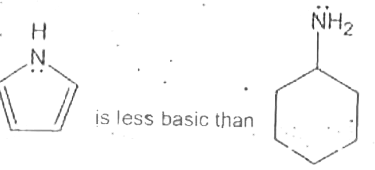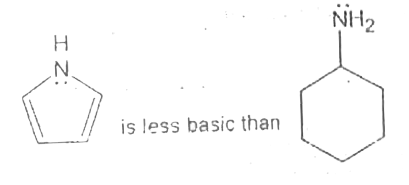Statement-1 Resorcinol turns FeCI3 solution purple
Statement - 2 Resorcinol is a dihydric phenol
Statement -1 is true ,Statement -2 is True , Statement -2 is a correct explanation for Statement −1
Statement -1 is True , Statement -2 is True Statement -2 is NOT a correct explanation for Statement −1
Statement -1 is True Statement -2 is False
Statement -1 is False Statement -2 is True
The correct Answer is:B
To analyze the statements regarding Resorcinol, we will break down the information provided in each statement and evaluate their validity step by step.
1. Understanding Resorcinol:
- Resorcinol is a chemical compound with the formula C6H6O2. It is a type of phenol that contains two hydroxyl (–OH) groups.
- The structure of Resorcinol can be represented as follows:
OH|C6H4−C6H4|OH
- The two hydroxyl groups are located at the 1 and 3 positions on the benzene ring, making it a dihydric phenol.
2. Evaluating Statement 1:
- Statement 1 claims that "Resorcinol turns FeCl3 solution purple."
- When phenolic compounds, such as Resorcinol, react with ferric chloride (FeCl3), they form colored complexes. In the case of Resorcinol, the reaction produces a purple color.
- Therefore, Statement 1 is True.
3. Evaluating Statement 2:
- Statement 2 claims that "Resorcinol is a dihydric phenol."
- A dihydric phenol is defined as a phenolic compound that contains two hydroxyl (–OH) groups. Since Resorcinol has two –OH groups, this statement is also True.
4. Conclusion:
- Both statements are true:
- Statement 1 is true because Resorcinol does turn FeCl3 solution purple.
- Statement 2 is true because Resorcinol is indeed a dihydric phenol.
- However, the statements are independent of each other; one does not explain the other.
Final Answer:
- Both Statement 1 and Statement 2 are true, but Statement 2 does not explain Statement 1.
- Resorcinol is a chemical compound with the formula C6H6O2. It is a type of phenol that contains two hydroxyl (–OH) groups.
- The structure of Resorcinol can be represented as follows:
OH|C6H4−C6H4|OH
- The two hydroxyl groups are located at the 1 and 3 positions on the benzene ring, making it a dihydric phenol.
- Statement 1 claims that "Resorcinol turns FeCl3 solution purple."
- When phenolic compounds, such as Resorcinol, react with ferric chloride (FeCl3), they form colored complexes. In the case of Resorcinol, the reaction produces a purple color.
- Therefore, Statement 1 is True.
- Statement 2 claims that "Resorcinol is a dihydric phenol."
- A dihydric phenol is defined as a phenolic compound that contains two hydroxyl (–OH) groups. Since Resorcinol has two –OH groups, this statement is also True.
- Both statements are true:
- Statement 1 is true because Resorcinol does turn FeCl3 solution purple.
- Statement 2 is true because Resorcinol is indeed a dihydric phenol.
- However, the statements are independent of each other; one does not explain the other.
- Both Statement 1 and Statement 2 are true, but Statement 2 does not explain Statement 1.
Similar Questions
Statement-1:

Statement-2:
View SolutionStatement-1:The preparation of G.R. occurs in solution phase.
Statement-2: The reaction will be explosive in solid phase. G.R. is
stable only in solution phase.
View SolutionStatement -1 : Phenol is more acidic than ethyl alcohol
Statement -2 : Phenol is a weaker acid than benzoic acid
Statement -3 : Phenol is a good substrate to prepare o- salicylic acid
View SolutionStatement-1 : When a cell is placed in hypertonic solution, it shrinks.
Statement : 2 Reverse osmosis is used for desalination of water.
View SolutionStatement-1- 1 Phenol is more acidic than water
Statement-2 Phenoxide ion is resonance stabilized.
View SolutionStatement-1: Conc. Solution of Li in NH3 is diamagnetic.
Statement-2: Mg/NH3 works as anti-hydrogenation agent.
Statement-3: LiCl forms LiCl.2H2O.
View SolutionStatement-1: The equation 3cosx+4sinx=6 has no solution.
and Statement-2: Due to periodic nature of sine and cosine functions, the equations 3cosx+4sinx=6 has infinitely many solutions.
View SolutionStatement -1 : When phenol is treated with PBr3 is gives bromobenzene.
Statement -2 It is an example of nucleophilic substitution
View SolutionStatement-1(Assertion) and Statement-2 (reason) Each of these question also has four alternative choices, only one of which is the correct answer. You have to select the correct choice as given below.
(a) Statement-1 is true, Statement-2 is true, Statement-2 is a correct explanation for Statement-1
Statement-1 is true, Statement-2 is true, Statement-2 is not a correct explanation for Statement -1
(c) Statement -1 is true, Statement -2 is false
(d) Statement -1 is false, Statement -2 is true
Statement -1 logx3.logx/93=log81(3) has a solution.
Statement-2 Change of base in logarithms is possible .
View SolutionStatement -1: Acetic acid has a molecular weight of 120 in benzene solution.
Statement -2: There is dimer formation by H-bonding.
View Solution
